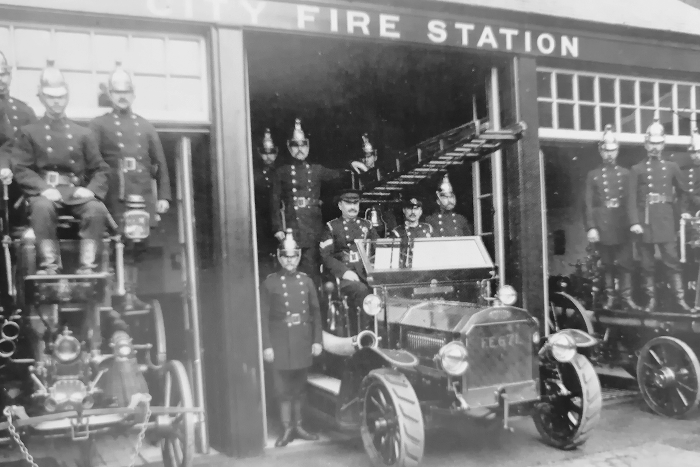
Two surviving former fire stations
Andrew Walker of The Survey of Lincoln, looks at two surviving but long-closed, fire stations near Lincoln’s city centre.
In 1964, a gleaming new fire station opened at South Park, which prompted the end of the working life of two other fire stations.
One had been housed in a building on Monks Road, which still survives today. The other was on Longdales Road, which had been opened as a temporary structure in 1944. This has since been demolished and replaced by housing.
An earlier fire station building which still survives is based on Church Lane, just round the corner from Newport Arch. This article will look briefly at the Monks Road and Church Lane buildings.
In December 1844, when there was a firemen’s strike in Lincoln the police superintendent Mr Mason declared that the fire engine and apparatus was ‘mouldy and in a bad state of repair’. Things did not appear to be much better in 1905 when the Chief Constable, whose police officers comprised the fire brigade, reported that the central fire station in Free School Lane (near where the Central Library is now situated) was ‘bad to get away from, very low and damp.’
In 1905 the decision was taken to build a replacement fire station in the Sessions House complex on Monks Road, which also included other facilities such as the central police station,
Although the new ‘fire engine house’, fronting Monks Road, was described in May 1906 as ‘large and roomy’, it was not sufficiently big to accommodate some bulky equipment, such as a canvas chute, which had to be kept in St Peter at Arches churchyard. Much of the space employed to accommodate the firemen comprised several disused cells under the Sessions House, previously housing prisoners in the old gaol, which had closed in 1876.
Houses at numbers 9 to 17 Rosemary Lane nearby were assigned to firemen and their families so that they could access the fire station quickly.
Until 1910, when Lincoln City Council bought its first ’motor fire engine’, a Dennis turbine engine, the fire brigade used horses to haul some of their equipment. They often took longer to get to the fire station than the men and were not used exclusively by the fire brigade. Until 1909, the horses belonged to the licensee of the ‘Saracen’s Head’ and it was not unusual to have to ‘round them up’ from various parts of the city before they could be employed on firefighting duties. Horses from J.H. Gadd’s liveried stables at St Mark’s were then used. A second motor fire engine was bought in 1915 and a third in 1923, which reduced the dependence upon horses.
At the end of the 19th century, with the rapid growth of a middle-class residential district uphill, ratepayers called for firefighting capacity nearby. A small fire engine house was built in 1880 as part of the Newport Police Station on Church Lane, and opened the following year, when the Lincolnshire Chronicle reported that the fire engine operator would be Sergeant Richardson, ‘a very courteous and obliging officer’.
Horses were supplied by the ‘Black Horse Inn’ on Eastgate. This was always the city’s ‘number 2’ fire station, with newer and more powerful equipment, such as the horse-hauled, steam-powered water pumps and, later, the motor fire engines, accommodated downhill.
By 1933, the Newport fire station component had ceased operating, though the police station remained, and a hose cart and fire-fighting apparatus were still stored there.
To find out more about The Survey of Lincoln and its work, see www.thesurveyoflincoln.co.uk.
Top picture shows the fire station at the Sessions House, Monks Road, 1912. (Maurice Hodson collection).
Below - the old Newport Fire Engine House on Church Lane.

